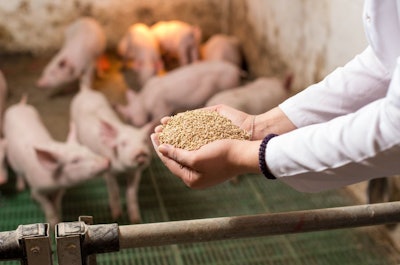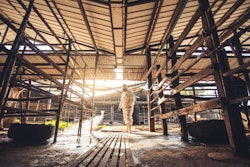
Scott Dee of Pipestone Applied Research discusses a real-life case where a previously naïve swine herd was infected with Senecavirus A through imported feed ingredients
PODCAST: Virus transmitted to pigs from soybean meal imports (13:38)
Ann Reus: Hello and welcome to the Feed Strategy podcast. I’m your host, Feed Strategy senior reporter Ann Reus.
Scott Dee is director of research for Pipestone Applied Research, where he conducts research in the areas of viral transport and transmission in feed, feed biosecurity and antimicrobial resistance on swine farms.
Along with two colleagues, he recently published research news in the journal Transboundary and Emerging Diseases on a real-life scenario where a virus was introduced to a pig herd via feed ingredients imported from a country known to be positive for this virus.
Dee calls this news a wake-up call for the United States, which is negative for viruses such as foot-and-mouth disease and African swine fever, which have trade implications and high pig mortality rates. He says this situation is proof that viruses can move from place to place in feed – something researchers have previously predicted – and that importers of feed ingredients should be cautious about the origins of their imports.
I recently spoke to Dr. Dee about this paper and its implications.
Hi, Dr. Dee. Thanks for being here.
Scott Dee: Hi, Ann. Thanks for the time.
Reus: You have a new paper in the journal Transboundary and Emerging Diseases. Can you tell me about what’s in it?
Dee: Well, yes, I’m very happy to do that. I think it’s like the smoking gun of feed risk for virus movement. We’ve been talking about that for many years from the laboratory level, but this is actually a real-world case, where a new virus entered a nationally naïve swine herd. So, the swine herd, which I can’t disclose where the country is, because it’s part of the deal, but Senecavirus is the virus. And then the Senecavirus entered this country for the first time, it had never ever been in the national herd. And the cause of the incursion, or the source of the virus was soybean meal that had come from a known positive country. So, very interesting case – you’ve got a country that’s been completely free of this virus, Senecavirus, all of a sudden gets it. And they figured it out that it came from the soybean meal from this country, which everybody knows is positive. So that’s kind of the basis of the case. I wanted to write that case up because it basically validated all our laboratory work – that feed could move viruses from place to place.
Reus: OK, and we’ll talk about that case in more detail later. But first, can you talk about Senecavirus A and what our listeners should know about it?
Dee: Yeah, Senecavirus A is a virus that’s in the United States, it’s in many countries, it has no trade implications at all, no human health implications. It only infects pigs, but the interesting thing about it is it’s related to foot-and-mouth disease virus. It’s almost like a brother to foot-and-mouth disease virus. It’s the same virus classification, same size and shape, and produces are the same clinical signs – that is vesicles, or vesicular lesions, on the on the nose and on the mouth and on the feet of pigs. So it looks just like foot-and-mouth, but it’s not foot-and-mouth.
Reus: So, you touched on it, but can you explain a little more why this research news is important?
Dee: Well, this is the first case that we’ve ever been able to show under a natural, real-world setting where a virus, in this case, Senecavirus, entered a naïve country so that all the pigs in the country had never seen this virus, they’ve never had vesicular lesions in their national swine herd. And it appears to have come in through a soybean meal import from a country that’s known to be positive to Seneca and has actually documented the presence of Senecavirus in their commercial feed system. We set this up in the laboratory and try to reproduce these types of events by putting viruses in feed and doing things to the feed, giving it to the pigs and see what happens. This actually happened all on its own. So that’s why it’s so important. It’s proof that viruses can move from place to place in feed.
Reus: Well, let’s go into some more detail about that situation – this case from July that you outlined in the paper. What happened in this instance?
Dee: Yeah, so the country that had the Seneca incursion is a very modern, highly productive, sophisticated pork-producing company. However, they made the mistake of introducing or importing feed ingredients from another country and this country did not have the level of health that the initial country did. So it had Senecavirus. And so they actually imported feed from the second country and it looks like they brought the virus in.
Reus: When you sent me this new paper, you said it doesn’t involve African swine fever, but it certainly could have. What did you mean by that and what implications could this information have on the ability to prevent the spread of ASF?
Dee: Well, that’s the fortunate thing about this situation was this was not ASF, this was not foot-and-mouth disease virus, this was Senecavirus. Senecavirus has no trade implications, it is very, very minimal of a problem. The problem is almost basically cleaned up. But if it had been one of those other diseases, there would be a very different story. Obviously, trade would stop, there’d be a lot of mortality in the national herd, it’d be a real disaster. So that’s like a wake-up call, that we, as the United States have to be aware that this can happen, that we could possibly get ASF, we could possibly get foot-and-mouth through the importation of feed ingredients, particularly soy-based products from countries of high risk.
Reus: And this is exactly what previous research has warned about, right?
Dee: Exactly. We’ve been doing this for eight years now, myself, many other scientists around the U.S., we’ve reproduced this in the lab many times with many different viruses. And this happened exactly the same way as we had predicted it would, based on the laboratory data. To me, it was very fulfilling, because it actually showed that everything we’ve predicted can indeed be true. And it validates all the work. The good news is, the country’s getting over this problem and it’s not going to bother it long term. So, pretty interesting, I think, from several points of view.
Reus: Can you explain the methodology that your team went through to identify the source of the virus and how it spread?
Dee: Well, the one thing, yeah, this is an interesting story, because I’m really a journalist, in this case. The swine production system in the country, that I can’t obviously disclose, they did all the work. So the veterinarians in the company that got infected with Seneca, they did all the work. And they did the investigation, looking for where the Senecavirus may have entered the production system, as well as the country. So, they get the credit. I wish I could give their names on the citation, but I can’t do that. They don’t want their names on it right now. But basically, they went around and took samples of bulk ingredients, fine ingredients from the swine farms, they took environmental samples from the mills, from the storage areas, they took samples from the poultry enterprise, they took samples from the plant enterprise, part of their large agricultural business, they were looking for any possible way this virus might have entered the country, what was the vehicle, as we say, that could have moved this virus into the country. And really all the only place they found the Senecavirus was in a big shipment of soybean meal that had come in from the source country, the one that we knew was positive. That’s where they found it. And they actually found it in fairly strong quantities in this big bulk import of soy. They did find a little bit of it on the outside of a tote bag, but it was just a very small amount of the virus. There was, in contrast, quite a bit of the virus in this big importation of soy. So, credit to them. They went and collected dust, they collected grain probe samples, they looked everywhere they could, tested by PCR, and basically just found it in in one place.
Reus: And that sounds really similar to the kinds of testing that you and other research teams have been doing in controlled environments to try to replicate. Is that right?
Dee: Exactly. And you know, so what was interesting about this, those samples were positive by PCR, so showing that Seneca viral RNA, or the nucleic acid, was present. But when they fed the soy, they reproduced the disease. That’s what’s interesting. When they started feeding the soy, they mixed it into rations and fed it. That’s when they first noticed vesicular lesions on the pegs. So, it’s almost like a natural feeding bioassay showing that not only was the virus present, but it was alive, because the pigs who ate the diets that had the soy mixed in together with everything else, those were the pigs that that showed the lesions. So not only was the virus, the nucleic acid present, it looks like the virus was alive.
Reus: So, in this instance, was there a holding time or temperature holding that should have been put in place that wasn’t or does that not matter with this virus?
Dee: No, that’s a very good question. We’ve tested this virus quite a bit under different holding times and temperatures. It’s very stable. It lives in feed, especially soy for a very long time. You can inactivate it for at 30 days at 75 degrees Fahrenheit. We know that, we’ve been we’ve proven that. In this case, that wasn’t part of the plan. That soy came in, it started getting mixed straight into the diets and fed to the pigs. So that might be something to consider in the future is putting some of this holding time and temperature work into their biosecurity plan.
Reus: On that note, what do you think livestock and poultry producers and feed mill employees should take away from this paper?
Dee: First of all, that the risk of feed is real. There is no question, it is no longer just a laboratory experiment anymore. It’s something that agriculture in general in the feed industry needs to pay attention to. And I’m very pleased to see that the FDA Center for Veterinary Medicine recently published GFI 245, guide for industry 245, talking about risks for animal feed. They’ve now included text says, or language that says viruses can be hazards, can be risks. Previously it’d been Salmonella and toxoplasmosis, molds and mycotoxins and things, but actually now in that language, in that GFI 245, it mentions viruses for the first time. So that’s a huge outcome, I think, and I applaud the FDA Center for Veterinary Medicine for looking at the information and continually updating their guidance for industry.
I was at the USAHA, United States Animal Health Association, and I presented this case. And there were a lot of people in the audience that had heard the previous laboratory work. And they were very, very interested. These are these are state and federal officials. They are extremely interested in the fact that we now had a field case, or what’s called an epilink, showing a relationship between a real-world occurrence and an outcome. So, the importation of feed from a known positive source into a naïve national swine herd, the outcome being transmission of the disease. So, it was a good audience to talk to about this case, just because of the makeup of the people and in what they do for their careers. So, it went it went over very, very well. So, I’m happy about that.
Reus: The paper appears online in Transboundary and Emerging Diseases. A link is available at feedstrategy.com.
I want to thank Dr. Dee for joining me on the podcast, and thank you to the listeners for tuning in.


















